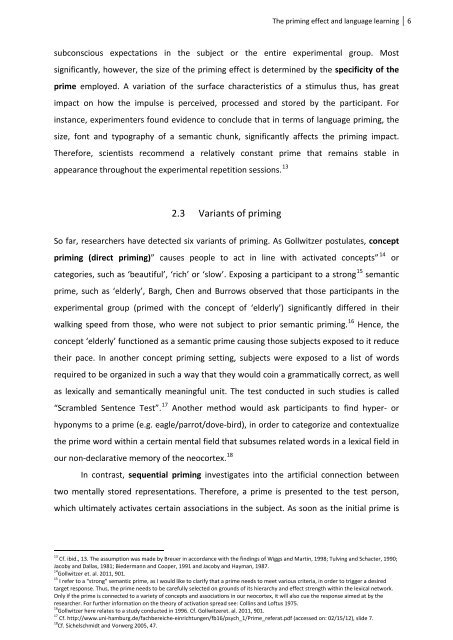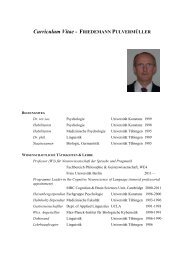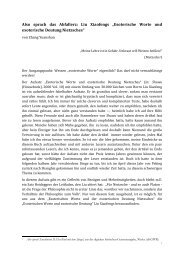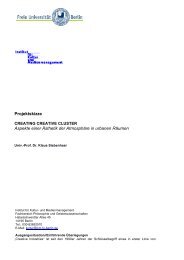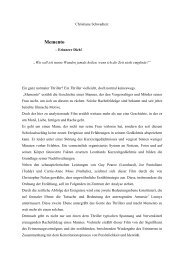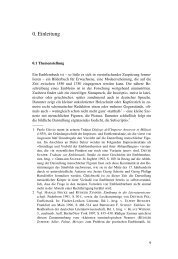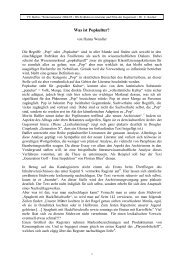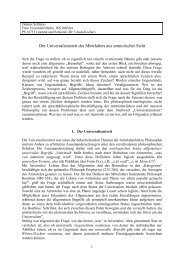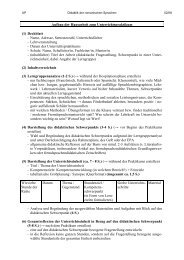3. Priming in action - Fachbereich Philosophie und ...
3. Priming in action - Fachbereich Philosophie und ...
3. Priming in action - Fachbereich Philosophie und ...
You also want an ePaper? Increase the reach of your titles
YUMPU automatically turns print PDFs into web optimized ePapers that Google loves.
The prim<strong>in</strong>g effect and language learn<strong>in</strong>g 6<br />
subconscious expectations <strong>in</strong> the subject or the entire experimental group. Most<br />
significantly, however, the size of the prim<strong>in</strong>g effect is determ<strong>in</strong>ed by the specificity of the<br />
prime employed. A variation of the surface characteristics of a stimulus thus, has great<br />
impact on how the impulse is perceived, processed and stored by the participant. For<br />
<strong>in</strong>stance, experimenters fo<strong>und</strong> evidence to conclude that <strong>in</strong> terms of language prim<strong>in</strong>g, the<br />
size, font and typography of a semantic chunk, significantly affects the prim<strong>in</strong>g impact.<br />
Therefore, scientists recommend a relatively constant prime that rema<strong>in</strong>s stable <strong>in</strong><br />
appearance throughout the experimental repetition sessions. 13<br />
2.3 Variants of prim<strong>in</strong>g<br />
So far, researchers have detected six variants of prim<strong>in</strong>g. As Gollwitzer postulates, concept<br />
prim<strong>in</strong>g (direct prim<strong>in</strong>g)” causes people to act <strong>in</strong> l<strong>in</strong>e with activated concepts” 14 or<br />
categories, such as ‘beautiful’, ‘rich’ or ‘slow’. Expos<strong>in</strong>g a participant to a strong 15 semantic<br />
prime, such as ‘elderly’, Bargh, Chen and Burrows observed that those participants <strong>in</strong> the<br />
experimental group (primed with the concept of ‘elderly’) significantly differed <strong>in</strong> their<br />
walk<strong>in</strong>g speed from those, who were not subject to prior semantic prim<strong>in</strong>g. 16 Hence, the<br />
concept ‘elderly’ functioned as a semantic prime caus<strong>in</strong>g those subjects exposed to it reduce<br />
their pace. In another concept prim<strong>in</strong>g sett<strong>in</strong>g, subjects were exposed to a list of words<br />
required to be organized <strong>in</strong> such a way that they would co<strong>in</strong> a grammatically correct, as well<br />
as lexically and semantically mean<strong>in</strong>gful unit. The test conducted <strong>in</strong> such studies is called<br />
“Scrambled Sentence Test”. 17 Another method would ask participants to f<strong>in</strong>d hyper- or<br />
hyponyms to a prime (e.g. eagle/parrot/dove-bird), <strong>in</strong> order to categorize and contextualize<br />
the prime word with<strong>in</strong> a certa<strong>in</strong> mental field that subsumes related words <strong>in</strong> a lexical field <strong>in</strong><br />
our non-declarative memory of the neocortex. 18<br />
In contrast, sequential prim<strong>in</strong>g <strong>in</strong>vestigates <strong>in</strong>to the artificial connection between<br />
two mentally stored representations. Therefore, a prime is presented to the test person,<br />
which ultimately activates certa<strong>in</strong> associations <strong>in</strong> the subject. As soon as the <strong>in</strong>itial prime is<br />
13<br />
Cf. ibid., 1<strong>3.</strong> The assumption was made by Breuer <strong>in</strong> accordance with the f<strong>in</strong>d<strong>in</strong>gs of Wiggs and Mart<strong>in</strong>, 1998; Tulv<strong>in</strong>g and Schacter, 1990;<br />
Jacoby and Dallas, 1981; Biedermann and Cooper, 1991 and Jacoby and Hayman, 1987.<br />
14<br />
Gollwitzer et. al. 2011, 901.<br />
15<br />
I refer to a “strong” semantic prime, as I would like to clarify that a prime needs to meet various criteria, <strong>in</strong> order to trigger a desired<br />
target response. Thus, the prime needs to be carefully selected on gro<strong>und</strong>s of its hierarchy and effect strength with<strong>in</strong> the lexical network.<br />
Only if the prime is connected to a variety of concepts and associations <strong>in</strong> our neocortex, it will also cue the response aimed at by the<br />
researcher. For further <strong>in</strong>formation on the theory of activation spread see: Coll<strong>in</strong>s and Loftus 1975.<br />
16<br />
Gollwitzer here relates to a study conducted <strong>in</strong> 1996. Cf. Gollwitzeret. al. 2011, 901.<br />
17<br />
Cf. http://www.uni-hamburg.de/fachbereiche-e<strong>in</strong>richtungen/fb16/psych_1/Prime_referat.pdf (accessed on: 02/15/12), slide 7.<br />
18<br />
Cf. Sichelschmidt and Vorwerg 2005, 47.


